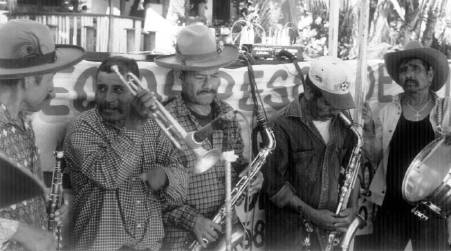

 The impressive creativity that characterizes the Oaxacan people is
apparent in the realm of music just as it is in the functional and
decorative arts. The great Isthmenian composer Jesús "Chu" Rasgado
produced an amazing body of work, including the haunting "Nayla".
The impressive creativity that characterizes the Oaxacan people is
apparent in the realm of music just as it is in the functional and
decorative arts. The great Isthmenian composer Jesús "Chu" Rasgado
produced an amazing body of work, including the haunting "Nayla".
But Oaxaca's most illustrious musical son was Alvaro Carrillo, whose legacy will be honored April 3, the anniversary of his untimely death in Pinotepa Nacional. (See the calendar)
An agronomist who discovered his true calling, Carrillo wrote more than 300 songs. He is best known for his romantic boleros, such as biggest international hit "Sabor a Mi." But he also wrote numerous chilenas, the music that was born in his native Costa Chica (small coast), such as the ubiquitous "Pinotepa", as well as classics such as "El Negro de la Costa," "El Bravero" and "Alingo Lingo".
Chilena music is sound and the soul of the coast and of its people, heard at all local fiestas: weddings, coming out parties (quinceañeras), birthdays, anniversaries, village fairs. Most of the chilenas we hear are performed by a banda, the brass band that you find in just about every village and town in the area.
Chilena dances are part of the rich folkloric heritage of the Mixtec, Amuzgos and Chatino Indians of the state. Couples always dance apart, pañuelo, or handkerchief, held high in the right hand.
 Chilena songs are built on an eight-syllable structure, preceded or
followed by a chorus that alternates with sections that are purely
instrumental.
Chilena songs are built on an eight-syllable structure, preceded or
followed by a chorus that alternates with sections that are purely
instrumental.
The lyrics speak of every day life, referring to love, women, elements of nature such as crops or animals, or paeans to the hometown. Some of the lyrics are quite risque, much to the delight of the audience.
As with many other aspects of the culture in this region, chilenas are a mixture of native Indian, Spanish and African elements. Spanish galleons carried African slaves on board their vessels as they sailed along the Pacific coast between Chile and Mexico.
Some experts believe that the predecessor to the chilena was the marinera peruana, a musical genre related to the traditional cueca of Peru and Chile.
One theory holds that immigrants from Chile, seeking their luck in the Gold Rush, brought the music with them when some settled, or were shipwrecked, in Mexico on their way to California. Spanish influences can be heard in the three-part measure and call and response cadences, classic elements in the music of Andalusia, where the first missionaries to the region came from.
The Fandango is a form of Chilena played by a band comprising two
guitars, a violin, cajon, charasco, cantera (all simple percussion
instruments: a wooden box, an ass' jaw and a pot, respectively) plus a
vocalist. In future issues, we'll explore the Jarabe Mixteca, Fandango
and that excellent music from the Isthmus.